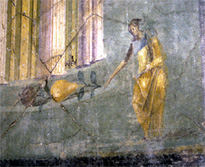Picard further explores the daring idea that these paintings represented pictorialised tomb facades and suggests that this possibility has…“been universally set aside until now, because no one was willing to admit that a Roman could have thought of having a tomb facade painted on his bedroom wall, a motif hardly conducive to pleasant thoughts: on the contrary, one likely to give terrible nightmares to whoever believed in ghosts, which was almost everyone. However this apparently absurd idea becomes less so if we remind ourselves of several well-known aspects of the old Roman religion” (Picard 1970: 97). At this point he supports his thesis by quoting Albert Grenier “the tomb was originally the common property of the family. The soul of the ancestors is supposed to survive, but on certain fixed days it haunts the home of the living. The Manes (shades of the dead), more or less mingle with the other gods of the house, the Lares and Penates. The very spirit of the father of the family is their emanation: he is represented by the serpent which emerges from the earth in order to come to taste the offerings of the family hearth.” (Grenier Religion Romaine p.87)
Picard continues… “Thus it is not extraordinary that the Door of the Shades, which they pass through especially on the night of the Lemuralia, is in the chamber of the head of the family. The origin of the theme of crossing over the wall is found therefore, in our view, in the old Italian beliefs, which were very much alive in Pompeii, as the existence of a lararium and a family altar in each house proves”. (Picard 1970: 97)
In the above quote Picard reveals the extraordinary fact that many of the tragic-style paintings were located on the walls of the master bedrooms. Having a tomb facade as a life-sized wall-painting situated in one’s house is extraordinary enough, but to locate it on a bedroom wall is truly extraordinary, especially in view of the macabre connotations associated with such an image. Yet, within the ancient Roman context, the Apollonian room of dreams appears to have functioned as a perfectly appropriate location for this type of mediumistic image; one which may have facilitated ritual communion with ancestors and protector-spirits of the household. The presence of votive culinary imagery supports this theory. A poignant example exists in the Museo Archeologico Nazionale di Napoli. It depicts votive motifs such as fish and fowl hanging either side of an entrance to a sanctuary, in which we are shown a woman laying an over-sized pear in front of a tholos shrine (figs.1-2). Votive culinary motifs in tragic-style wall-paintings located in triclinia (dining areas) also indicate that some form of ritual communion was associated with dining (fig.3). It was not uncommon to lay an extra place at a roman banquet for the souls of the departed or make food sacrifices to the gods during the banquet.
 1
1 2
2